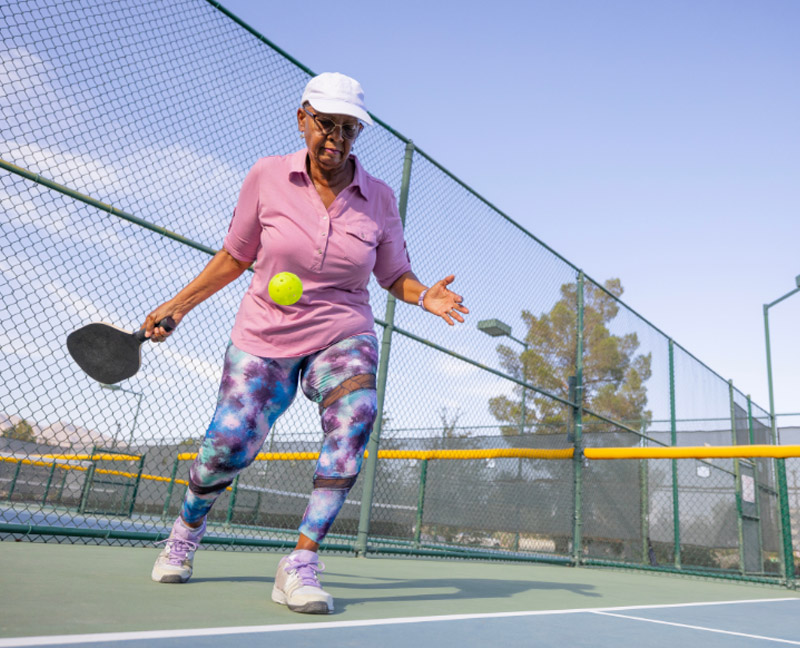Pickleball Pains: The Hidden Risks and Winning Strategies for Injury Prevention

Welcome, fellow sports enthusiasts and pickleball aficionados! As an orthopaedic surgeon specializing in sports medicine and shoulder surgery, Dr. Dante Marconi of Shore Physicians Group has witnessed the rise of pickleball’s popularity firsthand. He would like to shed some light on a topic that often goes unnoticed: pickleball injuries.
While this exciting sport brings joy to countless players of all ages, it’s crucial to be aware of the potential risks and learn how to prevent injuries. So, let’s dive into the world of pickleball and explore common injuries and winning strategies to keep you in the game for years to come!
The Pickleball Craze
Pickleball is a delightful fusion of tennis, badminton, and ping pong that has taken the sporting world by storm. It is easy to learn and low-impact, making it a favorite among both seasoned athletes and newcomers looking for a fun way to stay active. With millions of players worldwide, pickleball has become a social phenomenon, filling courts with laughter, camaraderie, and, unfortunately, occasional injuries.
The Reality of Pickleball Injuries
While pickleball is generally considered a safe sport, it’s not immune to its share of bumps, bruises, sprains, strains, and fractures. According to recent studies, pickleball-related injuries have steadily increased over the years, paralleling the sport’s exponential growth. According to UBS analysts, this year there will be an estimated 67,000 emergency room visits related to pickleball injuries, 366,000 outpatient visits and 9,000 outpatient surgeries. This upward trend emphasizes the importance of understanding and mitigating potential risks.
The Top Culprits
To ensure your pickleball experience remains injury-free, it’s crucial to recognize the most common types of injuries. Sprained ankles, strained muscles, tennis elbow (yes, even in pickleball!), and rotator cuff injuries frequently top the list. The sudden stops, starts, and lateral movements involved in the game can strain joints and muscles, especially if players fail to warm up properly or overexert themselves. Dehydration can commonly lead to injuries or other serious medical problems.
The severity of ankle sprains can vary, and some significant injuries can take more than six weeks to heal. Ankle fractures can also occur, leading to 3+ months of recovery before return to sport. Strained muscle recovery also depends on the level, which can take weeks to months before returning to sport. At times, players with overuse injuries, such as tennis elbow, can play through the symptoms. However, athletes may need treatments such as strapping, physical therapy, injections, and even surgery.
Similarly, rotator cuff injuries have a large spectrum of symptoms, and treatment will depend on the severity. Achilles tendon ruptures and foot fractures can also be seen.
An overwhelming majority of these injuries occur in players 60 years or older; therefore, increased awareness must be present in this age group.
Preventing Pickleball Pitfalls:
Now that we’re aware of the risks let’s explore some strategies to stay injury-free and make the most of our pickleball adventures:
- Warm Up and Stretch: Always dedicate time to warm up your muscles and joints before stepping onto the court. Gentle stretches and light aerobic activity will help prepare your body for the game ahead.
- Choose the Right Equipment: Invest in quality pickleball shoes with proper arch support and cushioning to minimize the risk of foot and ankle injuries. Additionally, consider using tendinitis straps or compression sleeves to support vulnerable joints.
- Know Your Limits: While it’s tempting to give your all during each rally, it’s essential to recognize your physical limits and gradually build your stamina. Overexertion can lead to fatigue, muscle strains, and even more severe injuries.
- Technique Matters: Learning proper pickleball technique and footwork is essential. Enlist the guidance of an experienced coach or join a beginner’s class to ensure you’re using the correct form and reduce unnecessary stress on your body.
- Listen to Your Body: Pay attention to any discomfort or pain during and after playing. Ignoring persistent aches can lead to further damage. If you experience chronic pain or a recurring injury, consult a medical professional promptly.
Pickleball offers a fantastic opportunity to stay active, have fun, and forge lasting friendships. By understanding the risks, recognizing common injuries, and implementing injury prevention strategies, we can all enjoy the game while minimizing the risk of sidelining injuries. So, grab your paddles, gather your friends, and let’s keep pickleball a sport filled with exhilaration and laughter for years to come! Remember, a healthy game is a happy game!